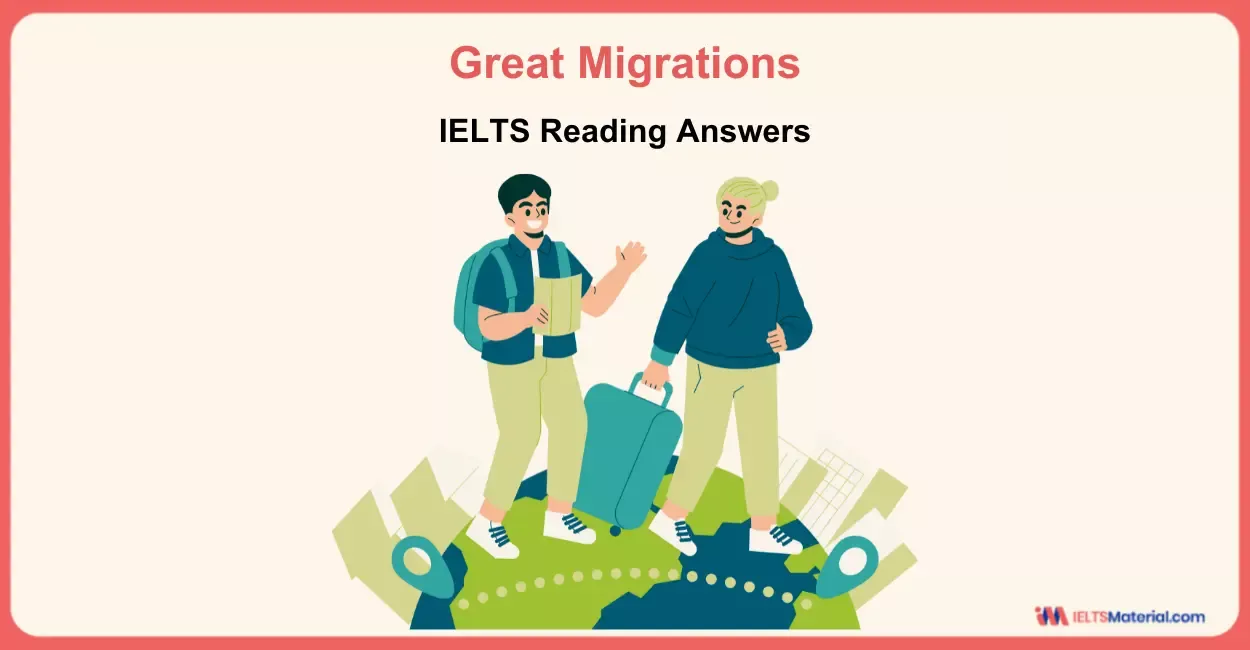900 Years: The Restorations of Westminster Abbey - IELTS Reading Answers
10 min read
Updated On
-
Copy link
Struggling to answer tricky IELTS Reading questions? Step into band 8+ tricks to attempt matching sentence endings, multiple choice, and matching heading questions in the passage ‘900 Years: The Restorations of Westminster Abbey’ with detailed answer key.
Table of Contents
- Types of Questions in IELTS Reading Passage ‘900 Years: The Restorations of Westminster Abbey’
- How to Attempt Tricky Questions in the Passage ‘900 Years: The Restorations of Westminster Abbey’?
- IELTS Reading Passage on ‘900 Years: The Restorations Of Westminster Abbey’
- Answers for the Passage ‘900 Years: The Restorations of Westminster Abbey’

Limited-Time Offer : Access a FREE 10-Day IELTS Study Plan!
The Academic passage ‘900 Years: The Restorations Of Westminster Abbey’ is a reading passage that appeared in an IELTS test. To achieve the best results in this section, you must learn how to skim, scan, and manage time while focusing on how to approach and answer different question types. By solving and reviewing the sample IELTS Reading questions from past IELTS papers, you can ensure that your Reading skills are up to the mark.
Let’s check it out now and take a step towards success!
Connect with our band 9 IELTS Trainers to crack your IELTS Reading in no time! Book a FREE Demo.
Types of Questions in IELTS Reading Passage ‘900 Years: The Restorations of Westminster Abbey’
Ideally, you should not spend more than 20 minutes on a passage. However, within this time, you will have to answer different questions for which it is necessary first to be aware of these types individually. Below are the questions which you will be asked to answer in the passage, ‘900 Years: The Restorations of Westminster Abbey’.
- IELTS Reading Matching Endings [Q.30 - Q.33]
- IELTS Reading Multiple Choice Questions [Q.34 - Q.36]
- IELTS Reading Matching Headings [Q.37 -Q.40]
How to Attempt Tricky Questions in the Passage ‘900 Years: The Restorations of Westminster Abbey’?
To score higher in the Reading section, you must first learn how to answer such tricky question types. Before you attempt these three question types given in the passage, keep in mind some general IELTS Exam Preparation Tips for Band Score of 8+. Remember that having a proper strategy would allow you to confidently and easily get the right answer for these questions. Let’s look below and understand how you can practice these questions and use their specific tips to your advantage.
- The first rule is to practice skimming and scanning techniques rather than going through every minute detail provided in the passage. Such skills will help you increase your reading speed and accuracy on the exam day.
- Attempt the question types individually at first so that you will know which strategy works for you to find the correct answer. This would improve your ability to answer different questions and prepare you for attempting the full-length tests.
- For the Matching Sentence Endings question type, always re-check if the sentence makes sense after choosing the correct possible answer. This would help you to be sure of the answer while moving on to the next question. Therefore, practice the main topics from IELTS Grammar.
- For the Headings types of question, double-check with the overall meaning of the sentence. This is because the text given in the passage may just rephrase ideas instead of repeating the same words.
- Study one question at a time and do not try to match all of them at once. This is because you need to decode the keyword first, for which you must learn How to Ace IELTS Reading with 'Keyword Technique'.
- Read the question first and avoid reading options for headings until you know what is being asked. Look at the options very closely because two choices may appear to be correct, but only one would be a perfect match.
- Always read the instructions given in the questions carefully before you start writing the answers. This will help you to be aware of the way you must give answers to the questions.
- Time Management for IELTS Reading is highly crucial as you need to have a watch or timer while you train your mind to answer under exam constraints. You will learn where to spend time and on which part while learning how to distribute time effectively.
Curious to learn how to improve your reading skills to get a band 9? Check out the video below!
IELTS Reading Passage on ‘900 Years: The Restorations Of Westminster Abbey’
You should spend about 20 minutes on Questions 1-13, which are based on the Reading Passage below.
900 Years: The Restorations Of Westminster Abbey
A. The exhibition in the summer of 1995 illustrated how Westminster Abbey has been transformed over the past nine centuries. Both its structure and its contents have been changed and changed about, but the identity of the building has never been lost. This process of change deserves chronicling as a subject in its own right, not as an apologetic footnote explaining why certain original features have been modified. For those of the Gothic Revival, such as William Morris, even by the 1890s the exterior of the Abbey had been 'damaged so vitally... that we have nothing left us but a mere outline, a ghost'. The 'ghost' has proved remarkably robust, the latest century of its history encompassing both aerial attack and painstaking restoration. This is a story worth telling.
B. Restoration, according to the meaning we give it today as a self-conscious process of repair and reinstatement of earlier features, only came to the Abbey at the end of the seventeenth century, with the campaign of comprehensive repair devised and carried out by Christopher Wren and his successors. This programme of work, covering the entire building both inside and out and setting out deliberately to respect the style of the original structure, was exceptional for its date, not only in England but anywhere in Europe.
C. Restoration can also be used in a wider sense to cover a process of renovation whereby the original fabric is replaced to a different design and in a different style, but respecting the meaning and ethos of the building. A famous example was the replacement by Bramante of the Early Christian basilica of St. Peter's in Rome with his Renaissance design, not regarded then as an act of vandalism, but as a restatement of the significance of the building for a new age.
D. The continuing vitality of an institution can be said to be expressed better by refashioning its buildings in a fresh style, rather than by patching up the old. It is in this way that the replacement of Edward the Confessor's Romanesque abbey church (11th century) by Henry III (13th century) in the up-to-date Gothic style can be considered as a work of restoration, not as a new building.
E. The meaning of restoration at Westminster can be vividly illustrated by an unexpected example: the history of the effigy of Queen Elizabeth I. This figure was dismissed for years as a second-rate eighteenth-century copy of the original. Indeed, the exterior of the Abbey has been regarded in a similar way. However, in the effigy as in the building, not only is the eighteenth-century interpretation of the earlier period important in its own right, but the early fabric turns out to remain at the heart. The effigy acquired a new head and new clothes in 1760, not through insensitive vandalism, but to show off Elizabeth's central role in the Abbey's history more effectively, just as Wren and Nicholas Hawksmoor had refaced the fabric of the building a few decades before. To try to strip away the contribution of later generations in order to reveal some mythical prime original is a profound misunderstanding of Westminster's rich complexity.
F. The relationship between the historical overview depicted in the exhibition and the restoration work in progress seen in the adjacent Mason's Yard was vital to the exhibition. The two pare gave meaning to each other the historical context gave validity to the current works, showing how this process of organic renewal has been present at the Abbey from the start, while the display of work in progress brought vividly to life the physical reality of the works exhibited.
Questions 30-33
Reading Passage has six paragraphs, A-F.
Choose one phrase (i-x) from the List of phrases to complete each key point below. Write the appropriate letters (i-x) in Boxes 30-33 on your answer sheet.
The information in the completed sentences should be an accurate summary of the points made by the writer.
NB. There are more phrases (i-x) than sentences, so you will not need to use them all. You may use each phrase once only.
30 The effigy of Queen Elizabeth I was ...
31 The Renaissance design for St Peter's was ...
32 A comprehensive assessment of the past was ...
33 A narrow, modern meaning of restoration states that it is ..
|
List of Phrases
|
Questions 34-36
Choose the appropriate letter A-D and write them in boxes 34-36 on your answer sheet.
34 At the end of the seventeenth century the Abbey was ...
- thoroughly repaired.
- conscientiously repaired.
- designed by Sir Christopher Wren.
- unusual for buildings of the time.
35 Which of the following has the Abbey retained through centuries of change?
- structure and contents.
- original features.
- identity.
- outline.
36 The writer believes that it is better ...
- to remove the work of later generations to expose the original features of a building.
- not to remove the work of later generations to expose the original features of a building.
- to reveal the mythical original architecture of a building.
- to enhance the rich complexity of a building.
Questions 37-40
Reading Passage has 5 paragraphs (A-E). Choose the most suitable heading for each paragraph from the List of Headings below. Write the appropriate numbers (i-xi) in Boxes 37-40 on your answer sheet.
One of the headings has been done for you as an example.
NB. There are more headings than paragraphs, so you will not use all of them.
|
List of Headings
|
37 Paragraph A
38 Paragraph B
39 Paragraph C
40 Paragraph D
|
Example |
Answer |
|
Paragraph E |
vii |
Grab the IELTS Reading (Academic) Test Guide: Essential Tips, Strategies, and Practice Tests” (April-June 2025) today!
Answers for the Passage ‘900 Years: The Restorations of Westminster Abbey’
Check out the answers along with answer locations and explanations for the passage on '900 Years: The Restorations of Westminster Abbey'. Keep note of the areas needing improvement, so that you may work on them before practising similar passages for a higher IELTS Band Score.
|
Question number |
Answer |
Keywords |
Location of keywords |
|
30 |
x |
The meaning of restoration at Westminster can be vividly illustrated by an unexpected example: the history of the effigy of Queen Elizabeth I. This figure was dismissed for years as a second-rate eighteenth-century copy of the original. |
Paragraph E;
Lines 1 – 2 |
|
31 |
iv |
A famous example was the replacement by Bramante of the Early Christian basilica of St. Peter’s in Rome with his Renaissance design, not regarded then as an act of vandalism, but as a restatement of the significance of the building for a new age. |
Paragraph C;
Line 2 |
|
32 |
vii |
The two pare gave meaning to each other the historical context gave validity to the current works, showing how this process of organic renewal has been present at the Abbey from the start, while the display of work in progress brought vividly to life the physical reality of the works exhibited. |
Paragraph F;
Last line |
|
33 |
v |
Restoration, according to the meaning we give it today as a self-conscious process of repair and reinstatement of earlier features,
& Restoration can also be used in a wider sense to cover a process of renovation whereby the original fabric is replaced to a different design and in a different style, but respecting the meaning and ethos of the building. |
Paragraph B;
Line 1 & Paragraph C; Line 1 |
|
34 |
B |
Restoration, according to the meaning we give it today as a self-conscious process of repair and reinstatement of earlier features, only came to the Abbey at the end of the seventeenth century, with the campaign of comprehensive repair devised and carried out by Christopher Wren and his successors. |
Paragraph B;
Line 1 |
|
35 |
C |
Both its structure and its contents have been changed and changed about, but the identity of the building has never been lost. |
Paragraph A;
Line 2 |
|
36 |
B |
It is in this way that the replacement of Edward the Confessor’s Romanesque abbey church (11th century) by Henry III (13th century) in the up-to-date Gothic style can be considered as a work of restoration, not as a new building.
|
Paragraph D;
Last line |
|
37 |
iv |
This process of change deserves chronicling as a subject in its own right, |
Paragraph A;
Line 3 |
|
38 |
v |
This programme of work, covering the entire building both inside and out and setting out deliberately to respect the style of the original structure, was exceptional for its date, not only in England but anywhere in Europe. |
Paragraph B;
Last line |
|
39 |
vi |
Restoration can also be used in a wider sense to cover a process of renovation whereby the original fabric is replaced to a different design and in a different style, but respecting the meaning and ethos of the building. |
Paragraph C;
Line 1 |
|
40 |
ii |
It is in this way that the replacement of Edward the Confessor’s Romanesque abbey church (11th century) by Henry III (13th century) in the up-to-date Gothic style can be considered as a work of restoration, not as a new building. |
Paragraph D;
Last line |
Enroll into our Free IELTS Webinar and learn more about techniques to improve your reading speed.
By practising with passages like '900 Years: The Restorations of Westminster Abbey', you can hone your skills at the IELTS Academic Reading module. However, you must maintain a record of your progress in order to identify the weak spots and continue to improve. So, get familiar with question types, strategies, and attempt a lot of passages to score a band 8+.
Check More IELTS Reading Answers
Also Check:
Practice IELTS Reading based on question types

Start Preparing for IELTS: Get Your 10-Day Study Plan Today!
Explore other Reading Practice Tests

Kasturika Samanta

Kasturika Samanta

Nehasri Ravishenbagam
Recent Articles

Nehasri Ravishenbagam

Haniya Yashfeen

Haniya Yashfeen

Haniya Yashfeen





Post your Comments